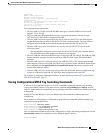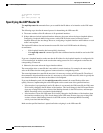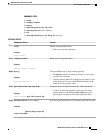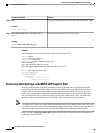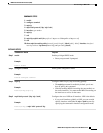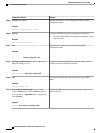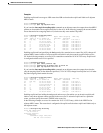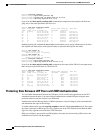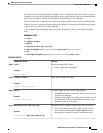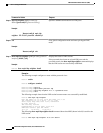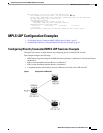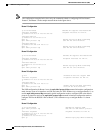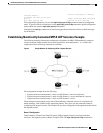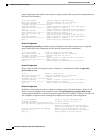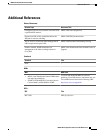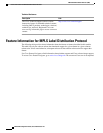
If a router has a password configured for a neighbor, but the neighboring router does not have a password
configured, a message such as the following appears on the console who has a password configured while
the two routers attempt to establish an LDP session. The LDP session is not established.
%TCP-6-BADAUTH: No MD5 digest from [peer's IP address](11003) to [local router's IP address](646)
Similarly, if the two routers have different passwords configured, a message such as the following appears
on the console. The LDP session is not established.
%TCP-6-BADAUTH: Invalid MD5 digest from [peer's IP address](11004) to [local router's IP address]
(646)
SUMMARY STEPS
1.
enable
2.
configure terminal
3.
mpls ip
4.
mpls label protocol {ldp | tdp | both}
5.
mpls ldp neighbor [vrf vpn-name] ip-address[password[0-7] password-string]
6.
exit
7.
show mpls ldp neighbor [[vrf vpn-name] [address | interface] [detail] | [all]]
DETAILED STEPS
Command or Action Purpose
Step 1
enable
Example:
Router> enable
Enables privileged EXEC mode.
• Enter your password if prompted.
Step 2
configure terminal
Example:
Router# configure terminal
Enters global configuration mode.
Step 3
mpls ip
Example:
Router(config)# mpls ip
Configures MPLS hop-by-hop forwarding globally.
•
The mpls ip command is enabled by default; you do not have
to specify this command.
• Globally enabling MPLS forwarding does not enable it on the
router interfaces. You must enable MPLS forwarding on the
interfaces as well as for the router.
Step 4
mpls label protocol {ldp | tdp | both}
Example:
Router(config)# mpls label protocol ldp
Configures the use of LDP on all interfaces. LDP is the default.
• If you set all interfaces globally to LDP, you can override
specific interfaces with either the tdp or both keyword by
specifying the command in interface configuration mode.
MPLS Label Distribution Protocol (LDP)
How to Configure MPLS LDP
MPLS LDP Configuration Guide, Cisco IOS Release 12.4
19



